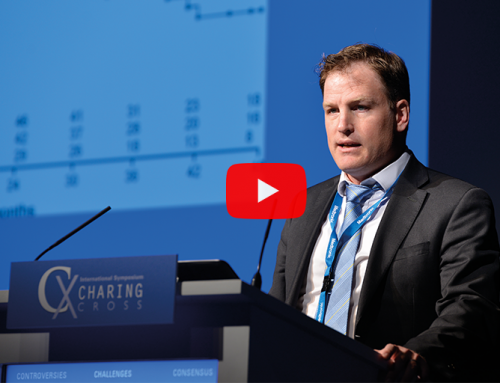Office-based lower extremity arterial interventions are feasible, safe, and cost-effective, and provide high levels of patient satisfaction. Enrico Ascher (Brooklyn, USA) presented data that “challenges the dogma that high-risk patients should not be offered office-based endovascular infrainguinal arterial procedures”. He was providing a US perspective on ambulatory interventions at CX Symposium 2019.
Ascher cited studies that show patient satisfaction levels with outpatient care of 99%, and listed its other advantages as improved physician efficiency, due to multitasking, better reimbursement levels, and increased independence for practitioners because hospital administrators are “cut out of the equation”.
He also highlighted his own data series, collected from 2014–2018 and based on 8,336 cases. There were no procedure-related deaths, and only onc case required an emergency transfer. The complication rate was 1.3%, and death rate at one month was 0.15%. Among the patients excluded were those who weighed >180kg, had advanced chronic obstructive pulmonary disease (COPD), disabling spine stenosis (and therefore could not remain supine), and unstable psychiatric patients.
From 2014–2018, there were 576 arterial interventions, with zero cases of embolisation, retroperitoneal bleed, and acute stenosis, and six cases of puncture site stenosis.
A review of the arterial patient selection criteria revealed that lesion type or location did not play a factor in patient selection, and that eligible patients were given a choice to have their procedure done in the office or in the hospital. Arko pointed out: “You would think that we would select patients with easy lesions, but that was not true.”
The data were then further evaluated by comparing findings in high-risk patients with those of more average risk. The risk factors analysed were age ≥80 years old, serum creatinine ≥2mg/dL or end-stage renal disease, ejection fraction (EF) ≤39%, and American Society of Anaesthesiologists (ASA) classification of 3 and 4.
For patients who were ≥80 years old, the reintervention rate at one year was 21% vs. 38% in the younger group (p=0.04). Of these, 18% were office-based and 1.4% were hospital-based for older patients, compared to 29% office-based (p=0.03) and 4% hospital-based reinterventions (p=0.18) among those of a younger age. No patients required a bypass.
A comparison between those with renal impairment and those with adequate renal function found a reintervention rate of 12% among high-risk patients, and 36% in the lower-risk group (p=0.01). All patients at higher risk had the repeat procedure performed in hospital, while only 4% of those patients with adequate renal function were hospital-based (p=0.21); 14 of the 297 reinterventions in the low-risk group required a bypass.
Reintervention rates for patients with impaired cardiac function—defined as an EF ≤39%—was 31% compared to those with adequate function at 34% (p=0.44). Only one of five reinterventions was office-based for those with impaired cardiac function, versus 84 of 105 cases among lower-risk patients (p=0.22). Two patients with EF ≤39% had a bypass vs. 12 of those with EF function ≥39%.
Outcomes for patients with an ASA classification of 3 and 4 were compared to those with a classification of 2, and found a reintervention rate of 12% among those at higher risk vs. 34% among the lower-risk group (p=0.44). Numbers of bypasses were the same in each group as for those among the high and low-risk cardiac function patients. The mortality rate was zero and there were no major amputations among any of the groups selected for comparison.
Limitations of the data analysis was that it was retrospective and single-centre, and based on a single surgeon performing >15,000 endovascular arterial procedures. However, Ascher concluded: “Appropriately selected high-risk patients can benefit from office-based endovascular arterial procedures,” adding, “ideally, office-based arterial endovascular procedures in high-risk patients should be further validated by a large multicentre prospective randomised study.”







